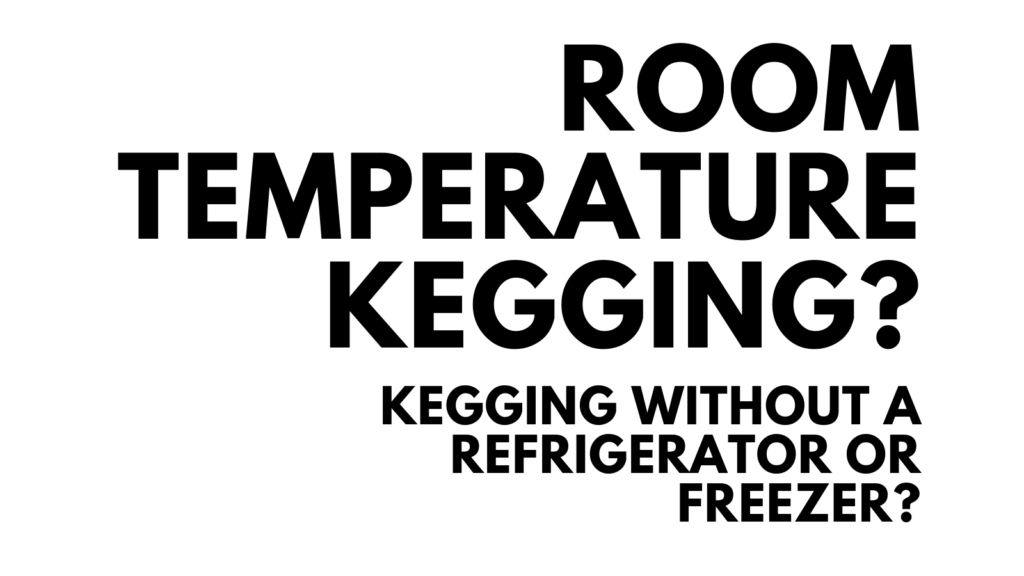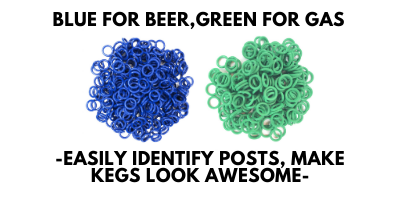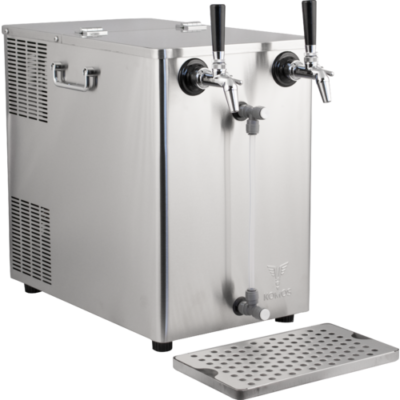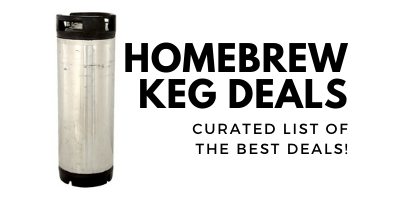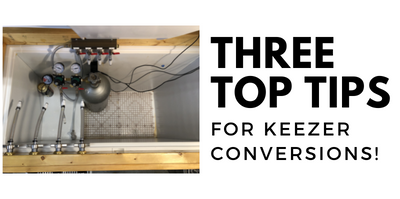
Room Temperature Kegging – Kegging WITHOUT a Refrigerator or Freezer?
I periodically get questions along these lines… can I keg without a refrigerator?
Well, the answer is, sure you can. But, as with many things, just because you can do something, doesn’t mean you should.
Balancing an Un-chilled System
The warmer your beer is, the less apt it is to absorb CO2. As temperature rises so does the pressure required to maintain carbonation. Let’s say your storage area is your basement and it stays at about 64 degrees Fahrenheit and you want something like 2.2 volumes of carbonation. A reasonable carbonation level for an American ale, Considering this example, you’d need to keep your CO2 regulator set to about 18 PSI. If you use 3/16″ ID tubing, you’d need somewhere between 6 and 12 feet of tubing [See: Step by Step Balancing Your Kegerator Draft System] to offset that pressure for a decent pour. I haven’t tried it, but my gut feeling is you’d be closer to 12 feet if not more. Lots of tubing. If there’s much of a temperature differential between the bottom and top of the keg, it may result in CO2 coming out of solution in that long length of tubing, causing excessive foaming, even if your system is balanced. This can happen even in a chilled kegerator [See: Kegerator Beer Line Temperatures & Reducing Foam with a Recirculating Fan] so it’s certainly a possibility for a room temperature setup.
Of course you can tweak this scenario with different numbers and maybe it looks better for you.
Temperature Swings = Bad Pours
If temperature varies in the spot that you’re keeping your un-refrigerated keg the setup will be even more temperamental especially at points when it’s warmer. Something like.. It’s hot outside today, my beer is going to be all foam.
This article contains affiliate links. We may make a small percentage if you use our links to make a purchase. You won’t pay more and you’ll be supporting Homebrew Finds and more content like this. Thank you for your support!
Why?
Why do it? I’m sure some people are doing this and it’s great. They like warmer beer at lower carbonation levels. If that’s you, awesome.. good for you! If not, I’d say pass, Stick with bottling until circumstances allow for a complete kegerator setup with chilling capabilities.
No Chill and No CO2 Kegging
Let’s take it a step further… I’ve also gotten this question – Can I keg without a refrigerator and without CO2? Well, maybe. You can prime and naturally carbonate a keg. One big issue with this is a lot of kegs don’t fully seal without pressure. So, you may need at least a small CO2 source to seal the lid. Beyond that, you’ve got the same issues outlined above with the additional problem of not having pressure to serve your keg. This beer is going to be relatively warm and as it’s served using pressure generated via natural carbonation it will become less and less carbonated. This can happen to the point that it may not completely vend under pressure.
Conclusions
Can you do it, yes. Should you do it? Probably not. My general recommendation is going to be the same as above… Stick with bottling until circumstances allow for a complete kegerator setup with chilling capabilities.
A New Option: KOMOS Draft Beer Chiller
Since this post was written MoreBeer has released KRYO Inline Beer Chillers. These allow you to serve draft beer without a kegerator. These will not be a reasonable solution for those looking save money, but they are a new option for those looking to save space.
- KRYO Inline Draft Beer Chiller | KOMOS® D1941
- KRYO Nomad Portable Inline Draft Beer Chiller | KOMOS® D1942
Two Spots to Look for Kegging System Deals
- Ball Lock Kegging Systems at AIH
- Homebrew Single Keg System | Basic Kegging Kit (Includes Ball Lock Keg! – This features premium components and when it’s on sale, is an outstanding deal
This article contains affiliate links. We may make a small percentage if you use our links to make a purchase. You won’t pay more and you’ll be supporting Homebrew Finds and more content like this. Thank you for your support!
Keg Deals!
kegdealsAdditional Resources and Related Products
- Rebuilding & Reconditioning Homebrew Kegs! – THE resource for helping you rebuild your kegs step by step
- Recent Keg Finds – our most recent keg finds
- Our Top Draft and Kegerator Resource Pages
- Upgrade Your Kegerator – 6 Improvement Ideas
- Home Brew Keg Roundup – New & Used, 5 and 2.5 Gallon & More!
- What’s the Difference Between Ball Lock Kegs and Pin Lock Kegs?
- Tips & Gear for Your Kegerator Resource Page – a collection of tips and gear for putting together your kegerator
- Kegerator Beer Line Temperatures & Reducing Foam with a Recirculating Fan
- Portable Draft Serving Options
- The Draught Quality Manual
- Ball Lock Kegging System via Adventures in Homebrewing
- Review: Inkbird Dual Stage Temp Controller
- Bulk Keg Orings and Keg Repair Part Numbers
- 5 Gallon Ball Lock Keg – via AIH
- Draft Landing Pages: More Beer – AIH – Keg Connection – William’s Brewing
- Review: Mark’s Keg and Carboy Washer
- Step by Step: Finding and Fixing Keg CO2 Leaks
- Build A Recirculating Draft Line Cleaning Pump
- Mark II Keg & Carboy Cleaner… As a Recirculating Draft Line Cleaning Pump
- The BJCP’s Style Guidelines
- Eva-dry E-500 for Kegerator Condensation – Hands On Review
- Checking for Draft System CO2 Leaks – Using The Pressure Gauge Method
- Tips and Gear for Growler Filling
Also: Kegerator Tips & Gear | Keg Repair Part #s | Recent Keg Finds
Our Top Draft Resources!
Check our our Top Draft Related Resources- Commentary: Pin Lock Keg Pricing and Availability
- Check Your CO2 Regulator for Leaks!
- How to get a keg ready for first use? New Keg Cleaning and Prep
- Portable Draft Beer Serving Options!
- Pin Lock Keg Pricing and Availability
- The Most Difficult Spot to Check for CO2 Leaks
- Keg O-Ring Materials Selection! – EPDM, Silicone and Buna-N?
- Why Do I Have Bubbles in My Beer Line? Diagnosing and Fixing Kegerator Foam Problems
- Five Benefits of Using Corny Kegs As Fermenters
- Rebuilding & Reconditioning Homebrew Kegs!
- Food Safe Replacement Keg O-Rings in Bulk
- Hands on Review: Kegland DuoTight Fittings & EVABarrier Tubing!
- Why Won’t My Beer Carbonate? Fixing Draft Beer Carbonation Problems
- What Does a Flow Control Faucet Do?
- Upgrade Your Kegerator – 6 Improvements!
- Serve Homebrew on Any Kegerator & Convert Commercial Kegerator to Homebrew
- Tips and Gear for Growler Filling
- What’s the Difference Between Ball Lock Kegs and Pin Lock Kegs?
- Checking for Draft System CO2 Leaks – Using The Pressure Gauge Method
- Tip: Consider Oetiker Stepless Clamps for Kegerator Gas and Beer Lines
- Hands On Review: Inkbird ITC-308 Dual Stage Temperature Controller +WiFi Version
- Universal Poppets Tips and Tricks!
- Convert Your Mark II Keg & Carboy Washer to a Recirculating Draft Line Cleaning Pump!
- Step by Step: Finding and Fixing Keg CO2 Leaks
- Kegerator Temperature Probe Placement – To Immerse or Not To Immerse? – three tests to determine optimal pla…
- Kegerator Beer Line Temperatures & Reducing Foam with a Recirculating Fan
- Kegging CO2 Use Estimations and Calculations
- Balancing Your Kegerator Draft System
- Building a Simple Ball Lock Draft Line Flushing Setup
- Build a Recirculating Draft Line Cleaning Pump
- Home Brew Keg Roundup – New & Used, 5 and 2.5 Gallon & More!
- Damp Kegerator? Fix Kegerator Condensation
- Homebrew Temp Controller Roundup! – Kegerator and Fermentation – concepts, applications and models
- Bulk Keg Orings and Keg Parts Reference
More Homebrew Finds!
- Last 50 Finds!
- Top Deals – a curated list of the best deals
- Homebrew Reviews – one of the largest libraries of homebrew reviews in existence!
- Our Top Posts – tips, how-tos, resources posts and more
- Let’s be Friends!
Recent Deals!
10 Most Recent Homebrew Resource Posts & How-To’s!
We are Homebrew Review HQ! Our 10 Most Recent Reviews
pinnedThis post may contain affiliate links. We may make a commission when you use our links. This will never cost you extra. Thank you for supporting Homebrew Finds!
greatdealsThis is a Top Post! See: All Top Posts
Make sure the components you use are compatible and rated for your intended application. Contact manufacturer with questions about suitability or a specific application. Always read and follow manufacturer directions. tag:lnksfxd toppost:nokegkegging tag:tpr
